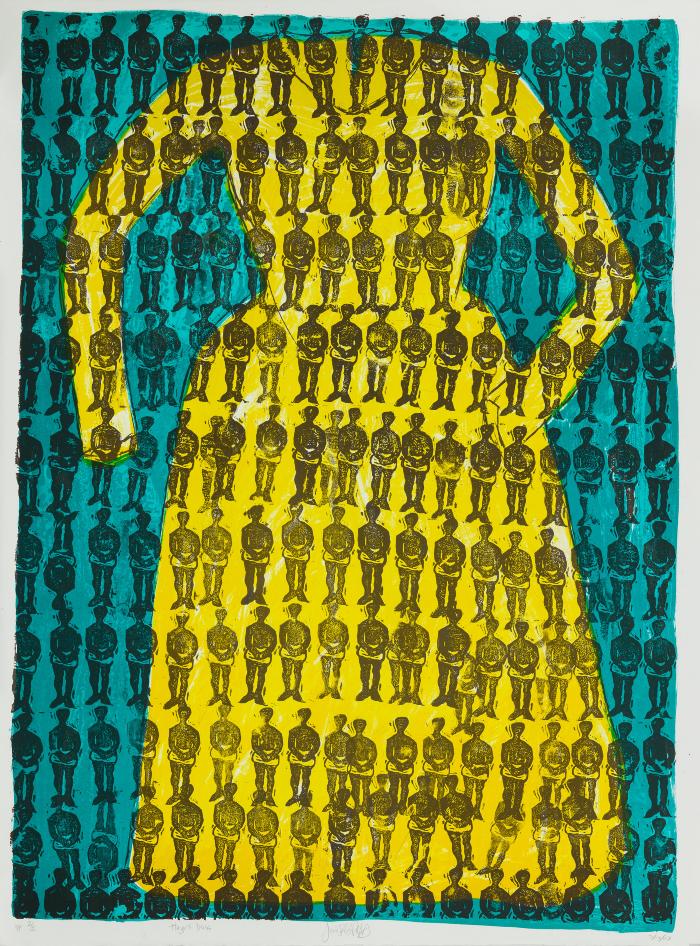
Hagar’s Dress
Janet Taylor Pickett
- 2007
- Offset Lithograph
- Image/sheet: 50 x 38"
- 20 prints in this edition
About the Print
From the Artist
When I arrived [at Brandywine Workshop and Archives, Philadelphia] I had a very loose concept of what I wanted to produce. I have been actively working on and toward a series of work involving the garment (i.e., the dress shape and form and the jacket). Each exemplifies the metaphor that the garment represents—that of identity.
This print, Hagar’s Dress, is part of The Middle Passage Suite, [a] series of work examining the “Crossings” that my ancestors made as well as my crossing over into middle age. Hagar was the “slave” woman that begat Abraham a child because his wife Sarah was unable to conceive. All that is history and part of Biblical record. What Hagar represents to me is the [inspiration], spirit, struggle and creativity in survival. For me the dress also symbolizes the beginning and the carrying on of one’s history. The figures I carved in order to create a repetitive pattern that represents the human beings that survived as well as those who did not. The colors are symbolic as well, blue, yellow/gold, and black-brown. The dress shape is meant to read as pre/post colonial—all women.
—From Brandywine Workshop and Archives records
As a mature artist still evolving, I see my art as experimental and collaborative. I’ve always been a narrative artist and my work is about my experiences as an African American female artist. It is very personal, yet the truths revealed are universal. I want the viewer to make a connection with their own life when they encounter my art. That is my intention as an artist.
—From https://foundwork.art/artists/janetpickett, accessed 7-14-2021
Through this depiction of silhouettes, Pickett references the famous diagram by British abolitionist William Elford that exposed the inhumane conditions enslaved people endured on ships that traversed the Atlantic. The print shows how 487 Africans, depicted as repeating silhouettes wearing nothing but undergarments, were packed into various parts of slave ships to maximize traders’ profits. The print was widely circulated, generated an uproar, and aided abolitionists in their work.
—From https://collections.telfair.org/objects/8498/hagars-dress?ctx=4c1e3340f7875945943e4307fd5301c4dc81a4df&idx=1, accessed 10-8-2021
About the Artist
Janet Taylor Pickett is a painter and printmaker born in Ann Arbor, MI. She earned her BFA and MFA from the University of Michigan School of Art & Design, Ann Arbor. Taylor Pickett continued her studies at Parsons School of Design and the Fashion Institute of Technology, New York City; and the Vermont Studio Center, Johnson.
Her work can be found in collections across the United States, including the Studio Museum in Harlem and the Schomburg Center for Research in Black Culture, New York City; Rutgers University, NJ; University of Michigan School of Social Work, Ann Arbor; Bristol-Myers Squibb, New York City; Philadelphia Museum of Art; University of Texas, Austin; and Harvard University Museums, New Haven, CT.
A longtime resident of New Jersey, Taylor Pickett lives and continues her practice in Los Angeles.
—From Brandywine Workshop and Archives records
Curriculum Connections
Suggested Topics for Expressive Writing
Expressive Writing
The writings of Haki R. Madhubuti reflect a similar way of stereotyping as the word-prints of Edgar Heap of Birds. People of African descent are disproportionately represented in entertainment—as dancers and singers, particularly—and in professional sports. They are perceived as physically strong and fast. In American society, Blacks may entertain, play sports — or cook and clean. Outside of those realms, however, Blacks both with and without advanced education, social prominence, and financial success are considered dangerous, therefore representing a threatening presence at both ends of the socioeconomic spectrum.
Our abilities as viewers to understand the messages and connections that the artists hope their imagery will convey is largely based on the extent of our own experiences and information that we bring to viewing and interpreting the artwork. In many countries, these types of messages are not brought to broad public attention and are often considered subversive.
Questions to Consider
- Why are some people considered a threat while others are not?
- Why is there education inequality in most developed countries?
- Who benefits from stereotyping others?
Related Media
- “America Calling” by Haki R. Madhubuti (Don L. Lee)
- “AWARENESS” by Haki R. Madhubuti (Don L. Lee)
- “Middle Passage” by Robert Hayden
- Amistad (1997 film) directed by Steven Spielberg
- Just Mercy (2019 film) directed and written by Destin Daniel Cretton
- King in the Wilderness (2018 documentary) directed by Peter W. Kunhardt
- Committed to Memory: The Art of the Slave Ship Icon by Cheryl Finley, PhD (2018)
